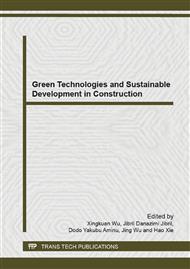p.71
p.76
p.80
p.84
p.88
p.92
p.97
p.102
p.106
Experimental Investigation on the Moving-Air Path in Roof Models with Thermal Performances Evaluation
Abstract:
The indoor thermal comfort is the basic thing for each and every occupant, not only in tropical areas but also all over the world. It is necessary to make an energy efficient roof design and to improve the indoor condition of the building. This paper is focused on the roof design to develop the ventilation system so as to obtain low attic temperature without effecting the environment and keep the interior of the building cool. In the present study, four identical roof models were fabricated to carry out laboratory tests to evaluate their performances. In the roof models, aluminum (Al) tubes were used as a moving-air path (MAP) which acts as a ventilation channel. These channels allows the natural ventilation to take out hot air to the outside. In addition, an insulation layer and ventilation fans were integrated with the Al tubes to get better performance. For the combination of those features, the results revealed that the attic temperature was reduced remarkably, compared to the ordinary roof model. This comprehensive roof model will be the most suitable to the environment and applicable for its improved performance.
Info:
Periodical:
Pages:
88-91
Citation:
Online since:
May 2014
Authors:
Price:
Сopyright:
© 2014 Trans Tech Publications Ltd. All Rights Reserved
Share:
Citation:


